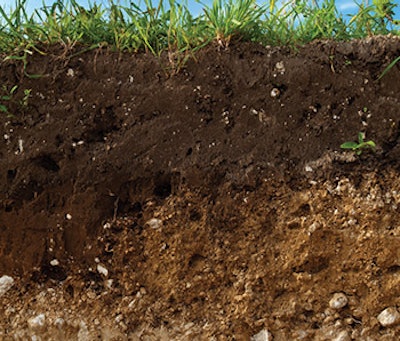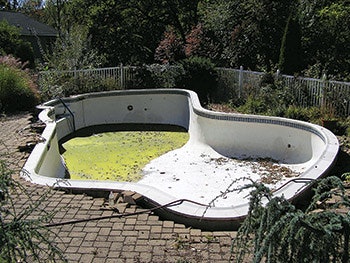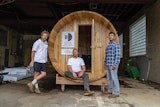
All swimming pools ultimately obtain their support from the ground, either by being buried in it or supported on the surface (such as elevated pools). The ground can consist of either soil, bedrock, or a combination of the two. When the ground consists entirely of bedrock, the only thing to worry about is how to make the necessary excavation. When the ground consists of all or part soil, however, interaction with the pool structure and surrounding decking should be considered.
Soil can be a complex and changing substance (hence engineers can justify the big fees). The main soil issues that affect pool builders are:
- Pool shell settlement
- Over/in native soil
- Over/in disturbed or fill soil
- Lateral (sideways) soil support
- Expansive clay
- Rock excavation and support
- Frost heave
- Groundwater during excavation and “popping” pool shells (buoyant force)
Soil/Pool Shell Settlement
For most natural soil deposits, settlement only needs to be addressed when there is an increase in the loading on the soil. Consequently, we do not usually worry about settlement for in-ground pools since the weight of the pool shell and water is significantly less than the weight of the excavated soil.
However, once a native soil has been disturbed, it becomes fill. If the fill has been placed under controlled conditions with proper moisture conditioning, compaction and testing, it is known as “engineered fill” and may be relied on for structural support. If not, it is known as “uncontrolled fill,” and it cannot be relied on for structural support of a pool shell.
The most common cause of structural pool shell failure is the presence of uncontrolled fill under the pool. Very loose fill under the decking will also settle and cause tilting and cracking of the decking. When uncontrolled fill is encountered in a pool excavation a local soil engineer should be consulted.
Lateral (Sideways) Soil Support
Most of the time, the soil along the sides of a pool excavation will “push back” with greater strength than the pool wall and water push out. However, if the soil is loose fill, then the pool wall may not have sufficient strength to resist the force of the water and the shell could crack. If there is adequate bearing support for the floor, then it is a simple thing to structurally strengthen the pool wall to act “freestanding” and not rely on the soil for support. This is routinely done in areas where an excavation ramp exists and the backfill is simply pushed in without any compaction. When in doubt about sidewall support, consult a soil engineer.




Expansive Clays
Clay soils are subject to volume changes with variations in moisture content. When moisture is available, they can swell, and when they dry out, they shrink. The forces behind this volume change can be substantial, easily enough to lift concrete decking and even a pool shell.
Expansive clay soils are located throughout the United States, but they often become more of a problem in semi-arid climates where there is a distinct wet and dry season. The maximum depth to which clay soils seasonally change moisture content (and therefore volume) is known as the active zone. If the active zone is greater than the pool depth, expanding clay soil can readily lift a pool (expansion pressure can be as much as 15,000 pounds per square foot).
In these cases the pool shell should be structurally strengthened to help it move as a unit, or it should be structurally isolated from the soil using piers and void boxes. However, if the active zone is less than the pool depth (which is more common), the main damage that expansive clays can cause is concrete deck heave.
For simple swimming pool deck construction, there are mainly two methods available for minimizing the potential for deck heave. One is to remove and replace the expansive soil with non-swelling fill. The depth of the removal and replacement is dependent on the type of clay (low, medium, or highly expansive) and the environmental conditions. Typical removal and replacement varies from 6 to 24 inches.
The other option is to pre-moisten and subsequently pre-swell the clay. It is usually the most economical option but should be done properly and to sufficient depth — this is more than just hosing down the subgrade before placing concrete.
Frost Heave
Frost heave can occur anywhere there is a sustained freezing climate. It happens when rising moisture within the soil is trapped below a frozen surface layer. The moisture condenses and freezes along the bottom of the layer, forming “lenses” of ice. Over time, these lenses can build up and cause the ground (or decking) to heave and crack. If a pool is drained over the winter, frost heave can crack the floor of the pool.
The best defense against frost heave is to have well-drained soil. Do not allow water to pool around the shell and decking. Do not allow a pool to be drained over the winter unless you are assured that there is good drainage in the underlying subsoil.
Ground Water Buoyant Force
Groundwater can present a problem both in constructing the pool and in the longterm stability of the pool. Groundwater seeping in the sides of the pool excavation can cause instability and cave-ins, and ponded groundwater in the bottom of the excavation can hinder the placement of reinforcement and shotcrete.
If the groundwater seepage is not excessive, then the most common approach is to place a layer of clean gravel (6 to 12 inches) in the bottom of the excavation with a sump pump installed near the main drain area. If sandy soil conditions exist and the bottom is pumping and unstable, then a layer of geotextile can be placed in the bottom before the gravel is placed.
The buoyant force from elevated ground water can easily “pop” an empty pool out of the ground. Any time groundwater is present, a pressure relief valve should be installed in the bottom of the pool along with a gravel layer, which allows water to easily flow to the valve.











































